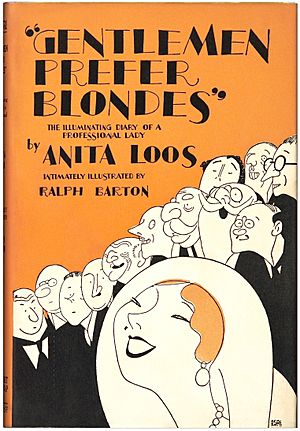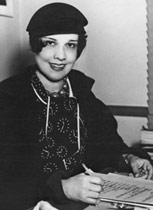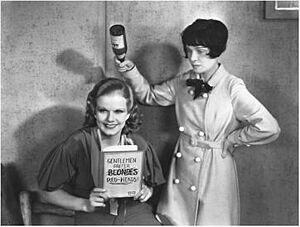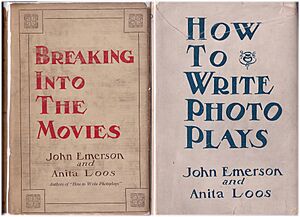Anita Loos facts for kids
Quick facts for kids
Anita Loos
|
|
|---|---|
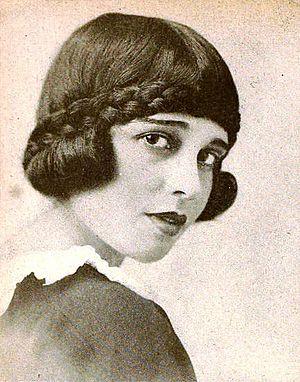
1916 portrait of Loos
|
|
| Born | April 26, 1888 Sisson, California, U.S.
|
| Died | August 18, 1981 (aged 93) New York City, New York, U.S.
|
| Resting place | Etna Cemetery, Etna, California |
| Occupation |
|
| Years active | 1912–1980 |
| Spouse(s) |
Frank Pallma, Jr.
(m. 1915; div. 1919)John Emerson
(m. 1919; |
Corinne Anita Loos (April 26, 1888 – August 18, 1981) was an American writer who worked as an actress, novelist, playwright, and screenwriter. In 1912, she became the first female staff screenwriter in Hollywood. This happened when D. W. Griffith hired her for Triangle Film Corporation.
She is most famous for her funny 1925 novel, Gentlemen Prefer Blondes. She also wrote the 1951 Broadway play based on Colette's book Gigi.
Life and Career of Anita Loos
Early Life and Writing Beginnings
Anita Loos was born in Sisson, California. Her parents were Richard Beers Loos and Minerva Ellen "Minnie" (Smith) Loos. She had a sister, Gladys, and a brother, Dr. Harry Clifford Loos.
Anita's father started a newspaper. Her mother did most of the work to publish it. When Anita was three, her family moved to San Francisco. Her father bought another newspaper there.
By age six, Anita Loos knew she wanted to be a writer. She went on exciting trips with her father to the pier. She explored the city and made friends with local people. Anita and her sister performed on stage when she was eight. Her sister Gladys sadly died young from appendicitis.
Anita kept acting on stage to help her family. Her father had money problems. In 1903, he took a job managing a theater company in San Diego. Anita performed in his company and another one.
After high school, Anita found a way to write about New York City life. She sent her first screenplay, He Was a College Boy, to a film company. She earned $25 for it. Her third screenplay, The New York Hat, was the first one made into a movie. It starred Mary Pickford and Lionel Barrymore. Anita used her own life and the people she knew for her stories.
By 1912, Loos had sold many scripts to film studios. Between 1912 and 1915, she wrote 105 scripts. Almost all of them were made into films. She wrote 200 screenplays before she ever visited a film studio.
Hollywood Success
In 1915, Anita married Frank Pallma, Jr. She wanted to escape her mother's worries about a Hollywood career. But Frank was not good with money. After six months, Anita left him and went home. Her mother then agreed to her Hollywood career.
Anita, with her mother, joined the film world in Hollywood. D. W. Griffith hired Loos for Triangle Film Corporation. She earned $75 a week, plus a bonus for each script made.
Many of her scripts for Griffith were not produced. He thought some were too funny in the words, not on screen. But he liked reading them. Her first screen credit was for a film based on Macbeth. Her name was listed right after Shakespeare's.
Griffith asked her to help write the titles for his big film Intolerance (1916). She went to New York City for the first time for its premiere. She stayed in New York and became a writer for Vanity Fair magazine for many years.
Loos returned to California and joined director John Emerson. They worked together on many successful movies starring Douglas Fairbanks. Loos and Emerson helped make Fairbanks a star. They used his natural athletic skills for exciting adventure roles.
Their film His Picture in the Papers (1916) was known for its clever titles. One famous title said: "To those of you who read titles aloud, you can't pronounce the Count's name. You can only think it."
The five films Loos wrote for Fairbanks made him very famous. Fairbanks offered Loos and Emerson a great deal with Famous Players-Lasky. They earned $500 a week. Loos became as well-known as stars like Lillian Gish and Mary Pickford. Photoplay magazine called her "The Soubrette of Satire." In 1918, Famous Players-Lasky offered them a deal for four more movies in New York.
Moving to New York
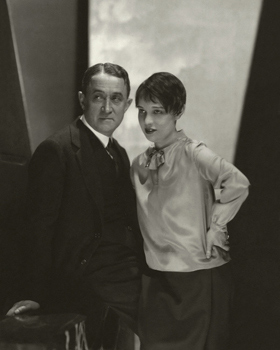
Loos, Emerson, and writer Frances Marion moved to New York. Loos and Emerson shared a large house. Loos was attracted to Emerson, who was 15 years older. She hoped he would be different from other people he knew. She later realized she was smarter than he was.
Their films for Famous Players-Lasky were not as successful. The scripts had both their names, but Loos wrote most of them. Loos later said Emerson took all the money and most of the credit. When William Randolph Hearst offered Loos a contract, she included Emerson in the deal. Their film Getting Mary Married (1919) was one of the first films for Marion Davies that made money.
Loos and Emerson also wrote two books about filmmaking. They were How to Write Photoplays (1920) and Breaking Into the Movies (1921).
They then wrote for their friend Constance Talmadge. A Temperamental Wife (1919) and A Virtuous Vamp (1919) were big hits. Loos and Constance often went shopping together. This time in Paris gave Loos ideas for her book Gentlemen Prefer Blondes.
After returning, they made five more films in 16 months. Loos divorced her first husband. Emerson proposed, and they married on June 15, 1919. Loos was one of the first to join the Lucy Stone League. This group fought for women to keep their maiden names after marriage.
The couple moved to a small apartment. They cut back to two films a year so they could travel. They spent a summer in Paris. Loos met many writers there, including Gertrude Stein.
After one more film, The Perfect Woman (1920), Emerson wanted to work in theater. Their first play, The Whole Town's Talking, opened in 1923. It got good reviews and was a success.
Emerson told Loos he needed a break from their marriage once a week. On these days, he would spend time with other women. Loos entertained her friends, including the Talmadge sisters and Marion Davies. These gatherings influenced her writing. She also loved visiting Harlem and learning about African-American culture. Loos wrote that her husband "liberated me; granted me full freedom to choose my own companions."
Loos admired writer H. L. Mencken. She would join his group of friends when he was in New York. Later, she started writing a story about Mencken. This story became Gentlemen Prefer Blondes.
Gentlemen Prefer Blondes
Gentlemen Prefer Blondes: The Illuminating Diary of a Professional Lady started as short stories in Harper's Bazaar. The main character, Lorelei Lee, was a smart and ambitious young woman. She valued money and possessions.
The stories were so popular that people wanted them in a book. The first printing sold out overnight in November 1925. It became a surprise best-seller of 1925. Other famous authors like William Faulkner and Edith Wharton sent fan letters to Loos. The book had 85 editions and was translated into 14 languages.
Loos said her characters were based on different people. Lorelei was like a showgirl named Lillian Lorraine. Lillian always looked for new places to show off her diamonds.
Emerson first tried to stop the book from being published. Loos worked very hard in 1926. She finished a stage play based on Blondes. It opened in Chicago and ran for 201 shows on Broadway. Emerson often pretended to be sick to get attention. A doctor suggested Loos should stop working for Emerson to get better. She decided to retire after her next book, But Gentlemen Marry Brunettes.
The couple planned a trip to Europe. Emerson insisted Loos go alone because he felt unwell. In London, Loos met many famous people like John Gielgud and Noël Coward. Photos of Loos in London appeared in New York newspapers. Emerson then joined her. They traveled to Paris. Their vacation ended early because Loos was needed in New York to revise Blondes for Broadway.
Life and Travel
But Gentlemen Marry Brunettes was published in 1927. Emerson suggested another European trip and went ahead. Loos followed him, feeling sick in Vienna. She and a doctor came up with a plan to help Emerson. The doctor pretended to do surgery on him. This made Emerson feel better. Loos decided to take a break from work.
The first film version of Gentlemen Prefer Blondes (now lost) came out in 1928. It was not very successful. From 1927 to 1929, Loos and Emerson traveled a lot. This was hard on Loos's health. They spent winters in Palm Beach. Emerson's throat problem returned, but he recovered quickly.
Loos and Emerson went to Hollywood in 1929 with photographer Cecil Beaton. Loos also spent time with her friend Wilson Mizner. When they returned to New York, Emerson was unhappy. He had also lost money in the stock market crash. He suggested Loos return to work. She wrote a play based on But Gentlemen Marry Brunettes.
With less money, they moved to a hotel. Loos offered Emerson a divorce, but he refused. He suggested they live apart. Loos moved to her own apartment. This new life allowed her to spend her own money as she wished.
When MGM offered them a job, Emerson refused to go. Loos took the $1,000-a-week salary alone.
MGM Screenwriter
The first project at MGM was Jean Harlow's Red-Headed Woman. Other writers had trouble with the script. Loos took over and finished it in May 1932. The movie was a huge hit. It made Harlow a star and put Loos back at the top of screenwriters.
Loos moved to an apartment in Hollywood. Emerson unexpectedly joined her. Loos was now free to see her friends.
At MGM, Loos wrote many scripts. She often had to use Emerson to talk to directors. This made it seem like they were a happy writing team. She bought a house in Beverly Hills in 1934. During the day, she worked. At night, she went to parties with other movie stars and executives. Loos often went to George Cukor's Sunday brunches.
In 1935, she worked with Robert Hopkins. Their work on San Francisco was nominated for an Academy Award. Loos based Clark Gable's character on people she knew.
After her friend and supporter Irving Thalberg died in 1936, Loos decided not to renew her contract with MGM. She signed with Samuel Goldwyn for $5,000 a week. She soon regretted it because the scripts were difficult.
Later Life and Memoirs
In October 1937, Loos and her brother helped Emerson get care for his health. Loos then found out that most of her money was in Emerson's private accounts. She was stressed and sad. Loos left her contract with United Artists and signed with MGM again. She bought a beach house in Santa Monica. After 17 years, Loos finally asked Emerson for a divorce. He agreed, but kept delaying it. When Emerson was well enough, she paid for a nurse to care for him in his own apartment.
MGM bought the rights to the play The Women in 1937. Many writers tried to adapt it for the screen without success. Loos and Jane Murfin wrote a script in three weeks. The censorship board made them change many lines. Loos worked on set with stars like Norma Shearer, Joan Crawford, and Rosalind Russell. Loos became good friends with Paulette Goddard.
During World War II, Loos wrote screenplays. She also grew vegetables and knitted for soldiers. She hosted Aldous Huxley and his family from England. Loos helped Huxley get a job writing screenplays at MGM. Eventually, MGM released her from her contract.
In 1946, Loos returned to New York. She worked on a play called Happy Birthday for Helen Hayes. The play opened in New York and was a hit. It ran for 600 performances. Loos sold her Santa Monica house. She made sure Emerson knew he would not join her in New York.
In New York, she worked with her friend, screenwriter Frances Marion. Two Broadway producers wanted a musical version of Gentlemen Prefer Blondes. It opened with a new actress, Carol Channing. The show was a success. Channing became a big star. The show ran for 90 weeks and toured for another year. A musical film version was made in 1953, starring Jane Russell and Marilyn Monroe. Loos thought Monroe was a great choice for the role.
The success of Blondes made Loos more famous than ever. She moved to a bigger apartment and bought a car. In 1950, Loos wrote another novel, A Mouse is Born. She then took her first trip to Europe in 20 years.
Loos then worked on a play based on Colette's Gigi. Colette found their "Gigi" when she saw Audrey Hepburn in a hotel lobby. Gigi opened in 1951 and ran until 1952. Hepburn became a major star.
Loos worked on more plays and traveled. Both Emerson and Helen Hayes' husband died. Loos worked on a film adaptation for Hayes. In 1959, Loos opened another play based on Colette's work, Chéri.
Memoirs and Final Years
Loos continued writing for magazines like Harper's Bazaar and The New Yorker. She was a great storyteller. Loos started writing memoirs. Her book A Girl Like I was published in 1966. Her 1972 book, Twice Over Lightly: New York Then and Now, was written with Helen Hayes. Kiss Hollywood Good-by (1974) was a very successful book about her years at MGM. Her book The Talmadge Girls (1978) was about actress sisters Constance Talmadge and Norma Talmadge.
Anita Loos became a well-known person in New York. She often went to parties, fashion shows, and movie events. She once said she loved wearing a fancy dress in a saloon.
She was interviewed in the TV show Hollywood: A Celebration of the American Silent Film (1980).
Death
After being sick with a lung infection, Anita Loos had a heart attack. She died in New York City at age 93. At her memorial service, friends like Helen Hayes and Lillian Gish shared funny stories. Jule Styne played songs from Loos's musicals, including "Diamonds Are a Girl's Best Friend".
Popular Culture
- Anita Loos is shown in the film Nickelodeon. The character is played by Tatum O'Neal.
Works
Fiction Books
- Gentlemen Prefer Blondes: The Intimate Diary of a Professional Lady. NY: Boni & Liveright, 1925
- But Gentlemen Marry Brunettes. NY: Boni & Liveright, 1927
- A Mouse Is Born. NY: Doubleday & Company, 1951
- No Mother to Guide Her. NY: McGraw Hill, 1961
- Fate Keeps On Happening: Adventures Of Lorelei Lee And Other Writings. NY: Dodd, Mead & Company, 1984
Nonfiction Books
- with John Emerson How to Write Photoplays NY: James A McCann, 1920
- with John Emerson. Breaking Into the Movies. NY: James A McCann, 1921
- "This Brunette Prefers Work", Woman's Home Companion, 83 (March 1956)
- A Girl Like I. NY:Viking Press, 1966
- with Helen Hayes. Twice Over Lightly: New York Then and Now. NY: Harcourt Brace Jovanovich, 1972
- Kiss Hollywood Good-by. NY: Viking Press, 1974
- Cast of Thousands: a pictorial memoir of the most glittering stars of Hollywood. NY: Grosset and Dunlap, 1977
- The Talmadge Girls. NY: Viking Press, 1978
Broadway Plays
- The Whole Town's Talking (1923)
- The Fall of Eve (1925)
- Gentlemen Prefer Blondes (1926)
- The Social Register (1931)
- Happy Birthday (1946)
- Gentlemen Prefer Blondes (1949)
- Gigi (1951)
- Chéri (1959)
- The King's Mare (1967)
- Lorelei (1974)
Film Credits
|
|
See Also
 In Spanish: Anita Loos para niños
In Spanish: Anita Loos para niños



